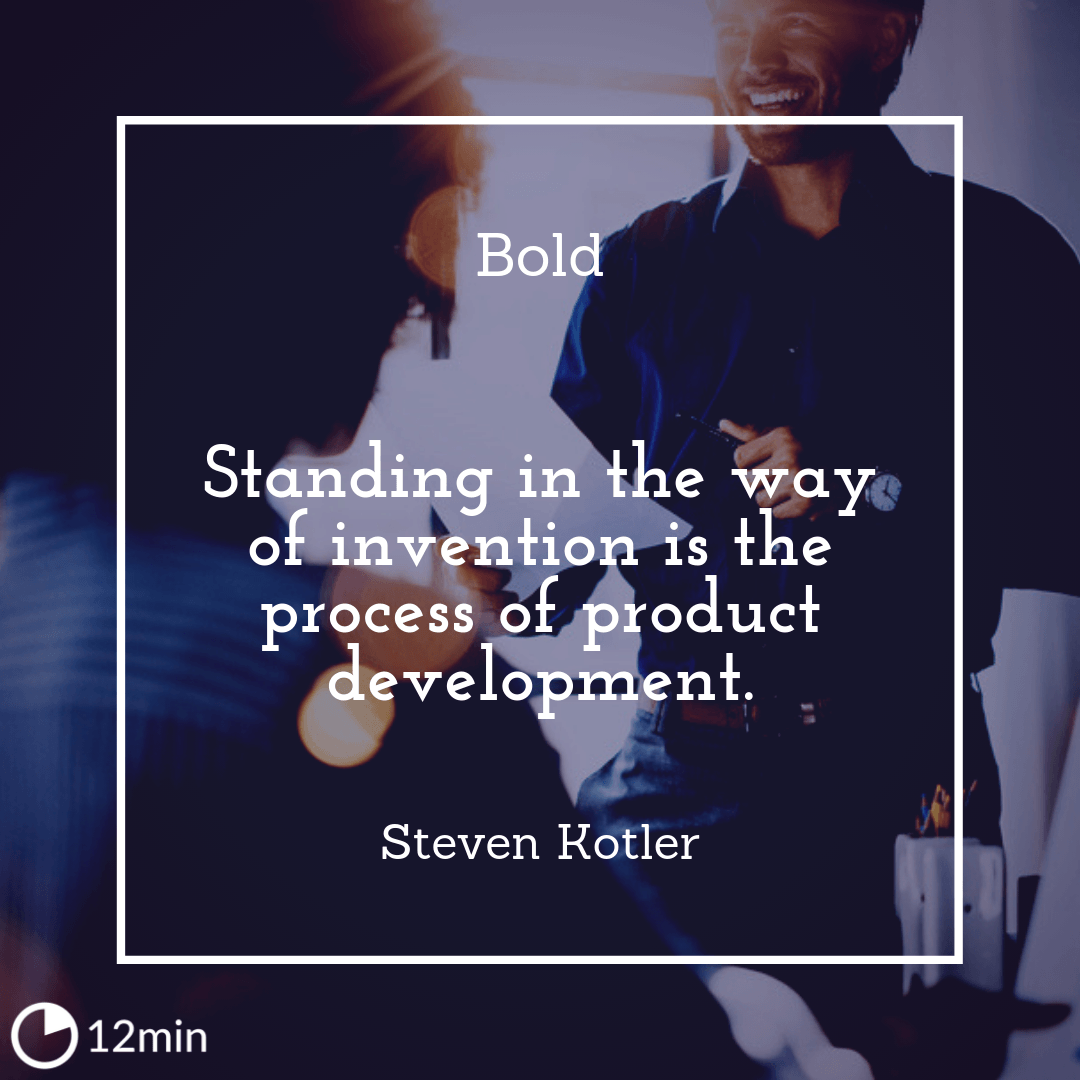Bold Summary

6 min read ⌚
How to Go Big, Create Wealth and Impact the World
Most of us think that “get a good job with more pay and you’re OK” is the way to go. Just calmly slide into a working schedule, pay your bills, your taxes, buy a car, maybe even eat in a nice restaurant once in a while. Bold by Peter Diamandis and Steven Kotler is not about that. It’s actually quite the opposite.
The book’s subtitle is How to Go Big, Create Wealth and Impact the World. Bold is about dreaming of going into space, building robots, altering DNA, improving lifespan. In other words, it’s about your big and (seemingly) unattainable dream. It’s about how to go out there and make that dream happen.
CHALLENGE THE IMPOSSIBLE / BOLD
Bold is about having the right frame of mind to shoot for the moon.
The authors know a little about doing the impossible.
“Bold PDF Summary – Steven Kotler”
Steven Kotler, besides starting a few businesses, is very interested in Flow. That’s the state of mind where everything, well… flows, depending on the field you’re focusing on. Then good ideas start to come to you, one after another, and “there’s a complete merger between action and awareness”.
It’s that total state of concentration where an athlete performs better than at practice. Where a writer can’t stop writing anything but good material. Or when a programmer has the best solutions for a coding problem.
Kotler has an upcoming book about Flow. He’s also the co-founder of the Flow Research Collective, an organization that delves into the science of human performance.
Peter Diamandis has dreamt of a space university (that’s currently based in Strasbourg, France). He founded the XPrize and co-founded the Planetary Resource company, which focuses on harvesting resources from asteroids. He also co-founded the Human Longevity company, which is pretty self-explanatory.
Now, about Bold. It’s divided into 3 main parts:
- Bold Technology
- Bold Mindset
- Bold Crowd
And it’s based on the 6 D’s:
- Digitalization
- Deception
- Disruption
- Demonetization
- Dematerialization
- Democratization.
Its main focus is exponential growth, driven by the evolution of technology and ways to handle this. It’s about how not to fall victim to that, but gain profit from it and, along the way, help the world become a better place.

Diamandis and Kotler seem determined to defy Murphy’s laws. They don’t believe in “whatever can go wrong, will go wrong”.
The prerequisite:
If something can go wrong: fix it!
From my point of view, this is the real but unofficial motto of Bold, because it captures both the “healthy disregard for the impossible” and the bold attitude the book contains.
Bold starts with a metaphor. It associates the asteroid that wiped out the dinosaurs with exponential technology. Just like the asteroid, the constantly-changing technology could kill the big, heavy, slow-reacting corporations.
And it’s doing that by making way for more agile, more open-minded and resourceful “mammals” – the small startups – to grow and evolve into something completely different in this new world order.
According to Peter Diamandis and Steven Kotler, we live in an age of abundance. The pair even wrote a book about this. It’s called – you guessed it – Abundance.
There are many fields about to explode. Bold continues this optimistic view of the future by describing how all this abundance of technology can make anyone with a passion for something a successful entrepreneur much easier than a few years ago.
We’re given a cautionary tale in the form of Kodak, how a company with over 140,000 employees can disappear in just a few short years. The mistakes Kodak made are described in more detail in the book.
But the bottom line is that in this new world order a company can go from monopoly to bankruptcy in a few years, while startups like Instagram, with a staff of only 13, are suddenly worth $1 billion.
This has never happened before, throughout our entire history. Kodak failed to take into consideration the exponential growth of photography and of mobile phone technology, and it suffered massively.
It is estimated that many big companies will no longer exist by 2020.
The main engine behind this exponential growth is digitalization. Everything these days is digital, and this means information becomes available to anyone around the world as it has happened (given a good Internet connection).
This also creates a lot of disruption. That is, it creates a new market; therefore, the old one disappears. That’s what happened to Kodak. Bold gives the examples of Quirky (which recently filed for bankruptcy), Airbnb and Uber. Disruptors who changed the way the game’s played because they could.
In case you’ve already forgotten, Quirky is a platform for presenting inventions. Airbnb is challenging the hotels and Uber, the taxis.
This process is now a lot easier to overcome.
Deception is the period in which a technology doesn’t reveal its true potential and has a relatively slow progress, or with little or no impact.
Computers are always a good example. Digital cameras are another one, providing new details about the downfall of Kodak.
The time period between deception and disruption is critical. Diamandis uses Moore’s law to predict when it occurs. Examples of staggering progress in robotics, artificial intelligence, 3D printing and so on leave us confused if we aren’t reading the right kind of literature.
These are the technologies exiting the deception period and starting the disruption. What will the consequences be? No one can tell yet. Bold isn’t concerned with this. Perhaps this is one of the weak points of the book.
After a technology “goes digital”, its costs drop dramatically, sometimes to practically zero and so demonetization occurs. Complicated stuff becomes easy and free and it sometimes replaces the need for material support altogether.
The smartphone is dematerialization materialized. It also represents democratization because it’s affordable and practically anyone in the capitalist world can buy one. This was unimaginable a few years ago.
But how is this amazing progress possible?
Part 2 of the book gives us a glimpse into the “bold mindset”.
Tesla CEO Elon Musk, Google CEO Larry Page, Amazon CEO Jeff Bezos and Virgin CEO Richard Branson are the four main examples given for this mindset, besides Diamandis himself. This is the part where, as they say, the magic happens. It is the core of the book.
After the introduction to exponential technology, we’re given real-life situations. There, the bold people, like the four mentioned above, having no wealthy backgrounds, went for those technologies. They grabbed them and took them for a rodeo ride through the ups and downs of the modern business and innovation environment.
I won’t give many details about this part, but while reading it, you’ll learn, amongst other things, about:
- “skunk” ( the importance of isolation and freedom when creating/inventing something).
- the above-mentioned Flow.
- the importance of “super-credibility” when presenting new ideas to investors – if no one believes you can do it, aim even higher and people will become excited and get involved.
- the feats of the above four listed gentlemen.
This isn’t hearsay. Peter Diamandis met with these men, worked with them, interviewed them, helped them, was helped by them and they share the same “bold” mindset. In short, that’s:
Have a healthy disregard for the impossible!
If you think it is impossible, then it is for you.
In other words, if something seems impossible, or an objective too big, then it means that there’s no competition That means that you can get the best people to work on it, because they want to work on the most ambitious thing.
You also get to read “Peter’s laws”, most of which you can also read in the nuggets. But in Bold there are additional explanations and guidelines to help you follow these laws and better understand them. You’re is also encouraged to create your own set of laws based on past experiences.

Once Diamandis and Kotler give us the right information and the right mindset, they continue by providing the necessary tools for making our bold ideas come alive:
- crowdsourcing
- crowdfunding
- exponential communities
- incentive prizes
This is the part where Bold gets more down-to-earth and lists some steps and cautionary ideas to help entrepreneurs harness the power of the crowd. But, of course, things immediately go big and the possibilities and resources that are at our disposal seem infinite.
It appears that we only have to be passionate about what we do, to truly believe in our projects and resources, and people and funds will appear. It’s not that simple, and Diamandis and Kostler offer a description of the pitfalls that we might encounter.
All these possibilities give the common man unprecedented power.
Une grande responsabilité est la suite inséparable d’un grand pouvoir. Voltaire
Or, to put it into plain English – “great power is followed inseparably by a great responsibility”.
The cautionary ending of Bold invites us to follow the path of the same exponential growth, not only in technology but also in developing our spiritual, moral and mental sides.
Like this summary? We’d Like to invite you to download our free 12 min app, for more amazing summaries and audiobooks.
Our Critical Review
If we succeed, the future looks set to have an unprecedented turn, in a good way, which our history as a species has never encountered before.
If a failure occurs, let’s hope it “fails fast and fails forward”.
Either way, after reading this book, the future certainly looks very interesting.








